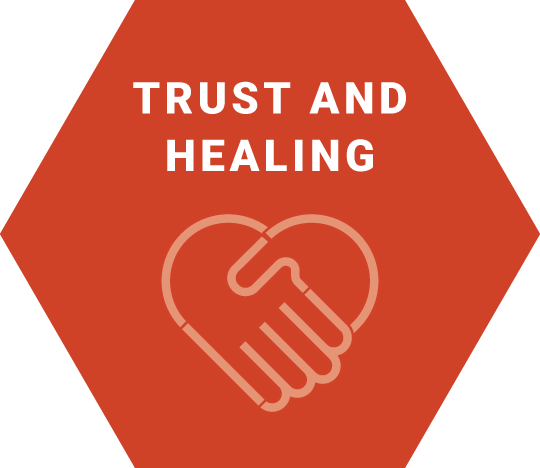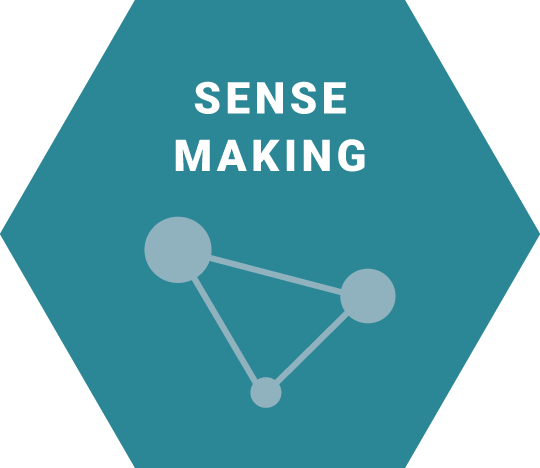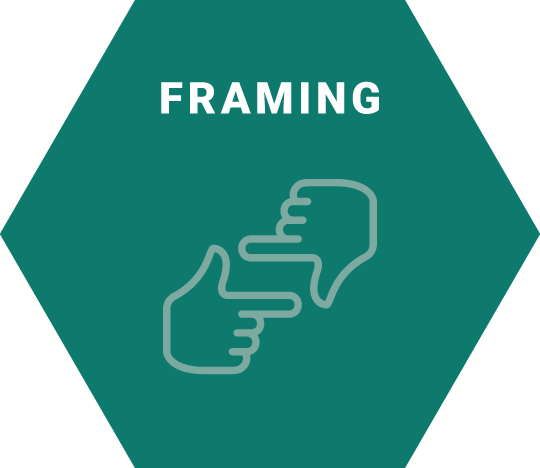| Module | Methods | Who | Where | When |
|---|---|---|---|---|
|
|
Story Circle |
Groups of your community who are often overlooked, who may need the most support, or who have experienced a recent setback or challenge. | Cornerstone establishments in the community (i.e., religious establishments, coffee shops, public schools). | Weeks 1-2 Two to three conversations of 60-90 minutes each. |
|
|
Interviews |
Follow-up with specific members from Story Circles. Key stakeholders who are driving the planning and implementation of the plan. |
Easily accessible locations for the participants to travel to. These could be local establishments such as restaurants, the school, or their home if relevant or preferred. | Weeks 3-4 Six to eight 30-60 minute interviews with community members; Two to four 30-minute interviews with key stakeholders describing context or background information. |
|
|
Affinity Clustering, Themes and Insights |
Core team members (core community representatives, CPS and Chicago team). | Core team project space (physical or virtual). | Week 5 90 minute session. |
|
|
Collective Mindmap |
Core team members (core community representatives, CPS and Chicago team). | Core team project space (physical or virtual). | Week 6 One hour workshop. |
The objective of this plan is to gather the requirements for a good community plan. You will build trust with key stakeholders, conduct interviews to learn about specific needs, and analyze the information to identify insights and gain an overall understanding of the context.
|
Who:
|
Where:Cornerstone establishments in the community such as religious establishments, coffee shops, public schools |
When:Week: 1-2 |
Supplies Needed:
|
Trust and Healing / Story Circles
Facilitate 2 to 3 x 60 to 90 minute Story Circles over the first two weeks with specific groups of your community who are often overlooked, need the most support or have experienced a recent setback. Do this to help foster trust and openness in the community, give voice to those who are sometimes left out of these planning initiatives, and help the project team uncover experiences that are often missed.
- Determine who should attend the Story Circle.
- Decide on a lead facilitator and note taker.
- Prepare any materials you will need during the session.
- Arrange the setup of the physical or virtual space.
- Maintain an arrival cut-off time. Late comers may not participate.
- Ask everyone to put everything away, silence all cell phones, and take everything off their lap.
- Welcome the group and introduce yourself.
- Ask if your team may take notes on the discussion to record ideas.
- Spend 5 minutes establishing community agreements.
- Share the background of Storytelling circles.
- Give instructions to invite people to share a story that lasts about 3-5 minutes in response to a prompt.
- Indicate that you will pass around a voice recorder giving each person the option to record, or not.
- Instruct each person to pass the recorder to the person on their left to speak.
- Each person is allowed to pass on their turn if they choose.
- Introduce guidelines for storytelling before beginning.
- Ask if anyone has questions before beginning.
- Give the prompt.
- After the initial pass of the circle, go around again to invite those who passed to share.
- Facilitate an open dialogue about key ideas, phrases and learnings once everyone has had a chance to share a story.
- Wrap up by thanking them and acknowledging their participation. Share any next steps.
- Follow up on any commitments you made during next steps.
LEARN MORE ABOUT THE STORY CIRCLE
|
Who:
|
Where:Easily accessible local establishments |
When:Weeks: 3-4 |
Supplies Needed:
|
Listening / Interviews
Conduct 6 to 8 x 1-hour interviews with specific members from the Story Circle in order to understand their experiences in more depth.
Conduct 2 to 4 x 30-minute interviews with key stakeholders in order to learn more context, background information or details of current/past initiatives.
- Plan your interviews by determining who you will talk to, how you will reach them, and what you want to know.
- Identify the type of interview (in-context interview or stakeholder interview) you will conduct.
- Assign roles and responsibilities for your team.
- Determine how long the interviews will be and where they will take place.
- Frame interview questions and write them down.
- Reach out to people you want to interview. Provide them with details about what to expect and schedule time with them.
- Before each interview ensure the person you are interviewing is comfortable.
- Set interview norms.
- Ask their permission before recording or taking photos or video.
- Ease into the conversation by asking them to introduce themselves.
- Ask questions and follow-up questions.
- Be careful to maintain eye contact.
- Ask one question at a time.
- Be patient and give the person time to respond.
- Avoid talking too much. The person you are interviewing is the expert, and you are there to learn.
- Wrap up your interview by asking them if they have any questions for you.
- Ask if you may contact them in the future.
- Thank them for their time.
|
Who:Core team members |
Where:Core team project space (physical or virtual) |
When:Week: 5 |
Supplies Needed:
|
Sense Making / Affinity Clustering, Themes, and Insights
Conduct an Affinity Clustering, Themes, and Insights exercise with the core project team in order to make sense of the information collected during the story circles and interviews, and identify key insights from the current experiences.
- Begin by making all of the relevant data points visible.
- Pin these to a wall, large sheet of butcher paper, flip charts, foam core boards or virtual white board.
- Choose one piece of data. Consider the meaning behind the statement.
- Compare the other pieces of data until you find a second that you think has a connection to the first.
- Write down the relationship in 1 - 3 words (a theme) next to them.
- Continue to compare the remaining pieces of data with the theme.
- If a data point easily fits within the existing theme, place it in the group.
- If a data point does not fit into an existing theme, place it to the side of the existing theme(s) to start a new group.
- Once a new group has multiple data points in it, label it with a theme.
- Repeat until you’ve worked through all the data.
- If a theme has many pieces of data, see if it can be further broken into multiple themes.
- If a theme has very few pieces of data, see if each piece of data will fit within a larger theme.
- Reflect on the connections between the data points in each cluster.
- Rewrite each final theme as one or two short sentences.
- Select one theme and ask “why”?
- Use the data points and your own perspective to write an insight that definitively, provocatively and completely answers “why”.
- Repeat this across all other themes.
- Once you finish, step back and assess your work.
|
Who:Core team members |
Where:Core team project space (physical or virtual) |
When:Week: 6 |
Supplies Needed:
|
Framing / Collective Mind Map
Conduct a Collective Mind Mapping exercise with the core project team in order to frame your view of what is happening in the community, and the forces impacting its current state.
- Set up a physical or virtual space that is big enough for everyone to see and contribute.
- Start by drawing a large bubble in the middle, and write inside that bubble the initial frame (i.e. the definition of the opportunity or challenge).
- Ask each participant to share their perspective with regards to that initial frame.
- Capture each keyword or short sentence in a new bubble, radiating out from the center.
- Keep balance by drawing new bubbles around your initial frame.
- Look for connections between bubbles and draw lines to represent these.
- Consider naming the lines and drawing some lines as arrows to represent direction when applicable.
- Populate a list of stakeholders on the side as individuals, groups or organizations are named during the exercise.
- Use a different color marker to circle concepts that have some affinity or connection to form clusters.
- Name each cluster in a way that makes sense to everyone.
- Collectively write a new frame, problem / opportunity definition, or decide next steps.



